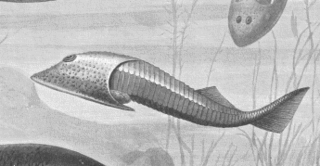
Cephalaspidomorphs are a group of jawless fishes named for Cephalaspis of the osteostracans. Most biologists regard this taxon as extinct, but the name is sometimes used in the classification of lampreys, because lampreys were once thought to be related to cephalaspids. If lampreys are included, they would extend the known range of the group from the Silurian and Devonian periods to the present day. They are the closest relatives of jawed fishes, who emerged from within them and they would survive if the jawed fish are included.

Dalmanites is a genus of trilobite in the order Phacopida. They lived from the Late Ordovician to Middle Devonian.
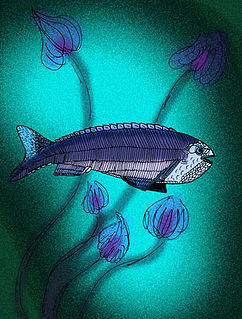
Anaspida is an extinct group of primitive jawless vertebrates that lived primarily during the Silurian period, and became extinct soon after the start of the Devonian. They were classically regarded as the ancestors of lampreys. Anaspids were small marine agnathans that lacked a heavy bony shield and paired fins, but have a striking highly hypocercal tail. They first appeared in the early Silurian, and flourished until the early Devonian, when they disappear from the fossil record.

The class Osteostraci is an extinct taxon of bony-armored jawless fish, termed "ostracoderms", that lived in what is now North America, Europe and Russia from the Middle Silurian to Late Devonian.

Galeaspida is an extinct taxon of jawless marine and freshwater fish. The name is derived from galea, the Latin word for helmet, and refers to their massive bone shield on the head. Galeaspida lived in shallow, fresh water and marine environments during the Silurian and Devonian times in what is now Southern China, Tibet and Vietnam. Superficially, their morphology appears more similar to that of Heterostraci than Osteostraci, there being currently no evidence that the galeaspids had paired fins. However, Galeaspida are in fact regarded as being more closely related to Osteostraci, based on the closer similarity of the morphology of the braincase.
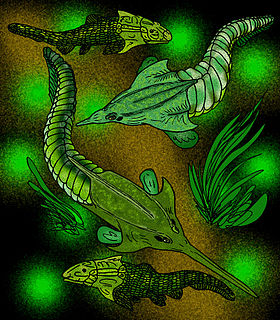
The Pituriaspida are a small group of extinct armored jawless fishes with tremendous nose-like rostrums, which lived in the marine, deltaic environments of Middle Devonian Australia. They are known only by two species, Pituriaspis doylei and Neeyambaspis enigmatica found in a single sandstone location of the Georgina Basin, in Western Queensland, Australia.

Cephalaspis is a possibly monotypic genus of extinct osteostracan agnathan vertebrate. It was a trout-sized detritivorous fish that lived in the early Devonian.

Boreaspis is an extinct genus of osteostracan agnathan vertebrate that lived in the Devonian period.

Pituriaspis doylei is one of two known species of jawless fish belonging to the Class Pituriaspida, and is the better known of the two. The species lived in estuaries during the Givetian epoch of the Middle Devonian, 390 million years ago in what is now the Georgina Basin of Western Queensland, Australia.

Greenops is a mid-sized Devonian trilobite of the order Phacopida, subfamily Asteropyginae. They are mainly reported from the mid-Devonian Hamilton Group of upstate New York and southwestern Ontario. A similar-looking trilobite from Morocco is often mis-labelled Greenops. Greenops had schizocroidal eyes, large genal spines and short, sharp spines at the tip of each segment of the pygidium ("tail"). Greenops lived in warm, fairly deep water. In the Hamilton Group of New York, they are found with Eldredgeops, Dipleura and Bellacartwrightia, a trilobite that resembles Greenops but has much larger pygidial spines. In Ontario, they are found in the Widder Formation, which outcrops at Arkona, where they are, by far, the dominant trilobite.

Benneviaspidida is an order of osteostracan jawless fishes which lived in the Early Devonian. The fishes in this order have a flat headshield and are dorsoventrally depressed. The first canal to lateral sensory field bifurcates near the orbit.
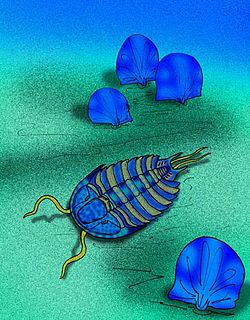
Meteoraspis is an extinct genus of ptychopariid trilobites of the family Tricrepicephalidae. The various species lived from 501 to 490 million years ago during the Dresbachian faunal stage of the late Cambrian Period. Fossils of Meteoraspis are characteristic of Late Cambrian strata in North America, though they are found in Late Cambrian strata elsewhere in the world, such as M. nevensis from Victoria Land, Antarctica.

Auchenaspis salteri is an extinct species of armored jawless fish of the order Thyestiida from the Late Silurian of England. In England, A. salteri's fossils are found in extreme abundance in the Lower Old Red Sandstone strata in Ledbury, Herefordshire.

Protopteraspis is an extinct genus of pteraspidid heterostracan agnathan with fossils known from Lower Devonian marine strata in Western Europe. The animal's somewhat flat build has led some to believe that it was a bottom dweller, living in freshwater areas. It has been described as "somewhat unspecialized". Its snout was round and narrow, shorter than that of its immediate relatives. Protopteraspis also did not possess the cornua (horns) found on the headshields of other pterapsids; rather, it had "small points" behind the gill opening. It did possess a "medium-sized" dorsal spine. Plates covering the headshield had ridges of dentine. It is theorized that the headshield formed in youth and that it grew via growth of the plates, which fused in adulthood. The scales of the animal were "small and diamond shaped".
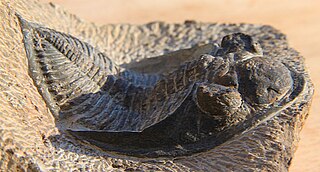
Odontochile is a genus of trilobites in the order Phacopida, family Dalmanitidae.

Viaphacops is a genus of trilobites in the order Phacopida, family Phacopidae, that lived during the Middle Devonian, and is known from North and South America, Asia.

Zenaspidida is an extinct order of osteostracans, a group of jawless stem-gnathostomes. They possessed a distinct headshield, which varied in width to length ratio by species.

Zenaspididae is an extinct family of jawless fish in the order Zenaspida.

Thyestiida is an order of bony-armored jawless fish in the extinct vertebrate class Osteostraci.

Wladysagitta is an extinct genus of osteostracan jawless fish that existed during the lower Devonian period of what is now Podolia, Ukraine. This taxon was named in honor of Polish paleontologist Dr. Władysław Zych (1899–1981), and from the Latin sagitta, meaning arrow, which is in reference to the arrow-like shape of its skull.



















